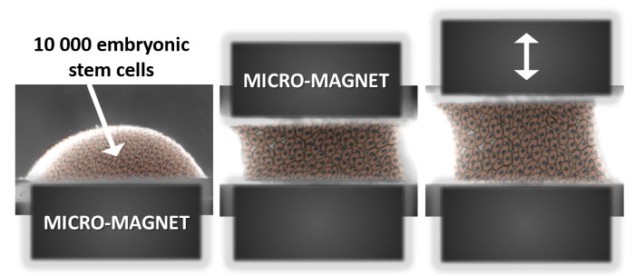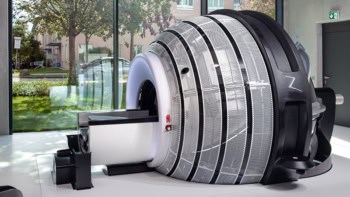
French researchers have aggregated stem cells containing magnetic nanoparticles to engineer a tissue that’s deformable at will using magnets. This approach does not require any external supporting matrix for the tissue and could be the building brick of the regenerative medicine of tomorrow (Nature Communications 8 400).
Stem cells are the cornerstone of regenerative medicine due to their unique ability to evolve multiple times into specific cell types – a process called cellular differentiation. We know that mechanical factors, such as stretching the cells, can greatly influence stem cell differentiation, as highlighted by many studies in both 2D and 3D cell cultures.
When studying the behaviour of stem cells in volumes, the most common technique uses scaffolds to control the spatial distribution of the cells; but the stretching motion is limited by the scaffolds, potentially hindering the differentiation process.
Bypassing scaffolds
The research team, led by senior author Claire Wilhelmbypassed the need for scaffolding by injecting magnetic nanoparticles into stem cells and using magnets to aggregate the cells, like Lego bricks, and form a tissue. A second magnet then stretched and compressed the tissue at will to drive differentiation.
Securing those results was not a foregone conclusion; Wilhelm and her team had to ensure that many conditions were met. They first had to show that incorporating the nanoparticles had no impact on the functioning of the stem cell or its ability to differentiate, and that the cell would remain magnetic long enough to force differentiation. When the viability of the created tissue was established, the researchers magnetically stretched the tissue and observed whether the mechanical stimulation impacted cell differentiation.
By imposing a “magnetic beating” that imitated the contraction of the heart, they observed that the magnetic stem cells were differentiating toward cardiac cell precursors, providing further evidence of the potential for purely mechanical forces to induce cell differentiation.
A powerful tool for regenerative medicine
Resorting to magnetic nanoparticles in regenerative medicine is not a novel idea, as various strategies have used such particles for noninvasive in vivo tracking of stem cells or for targeting. This is, however, the first time that researchers have used their magnetic properties to drive differentiation, outperforming the gold standard technique – the hanging drop method – in terms of the success rate of formation and control of the tissue created while requiring less manipulation steps.
Building and manipulating the tissue with magnets constitutes an “all-in-one” approach that avoids the usual caveats of traditional techniques. These promising results must now be repeated for differentiated cells other than cardiac cell precursors, but this method is a step forward toward easier and more customizable tissue engineering in regenerative medicine.



